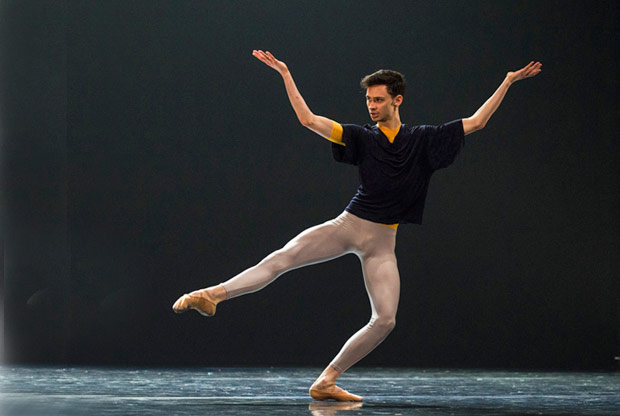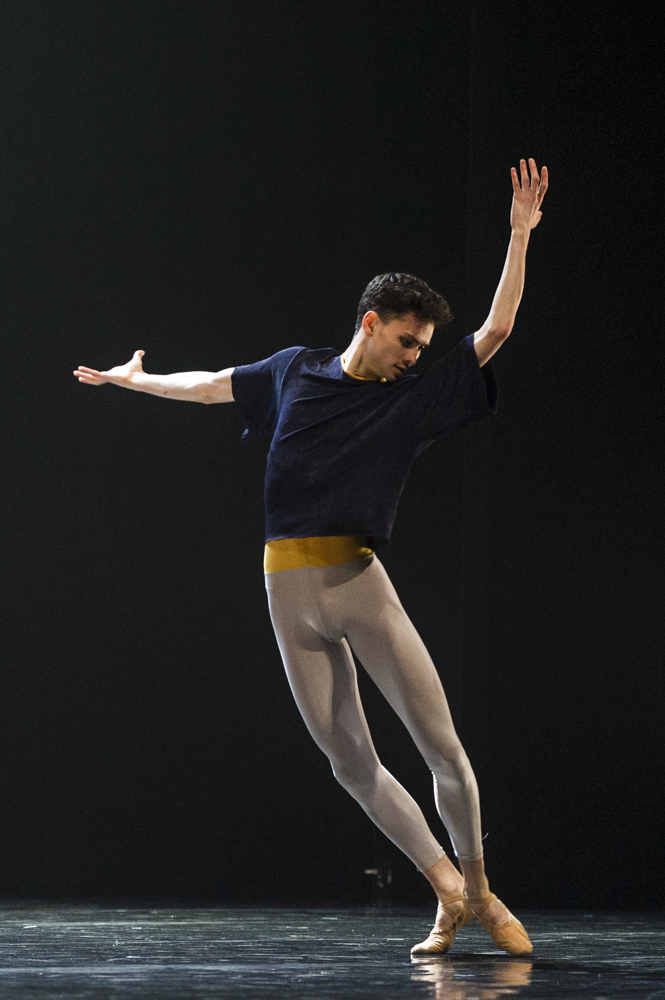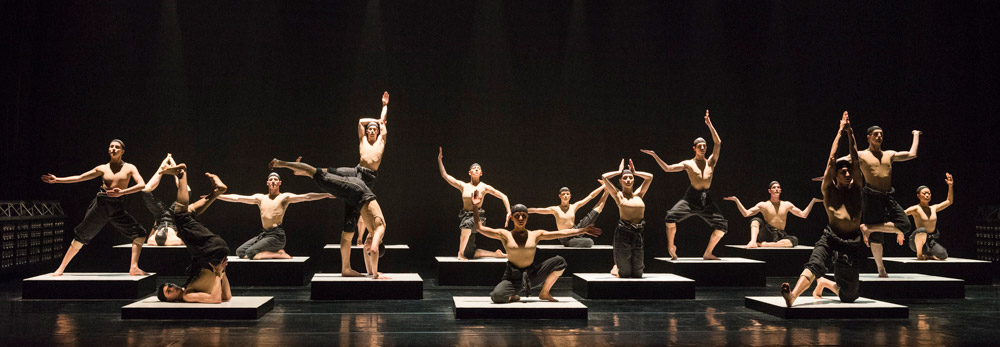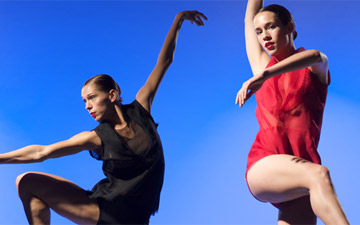
© Foteini Christofilopoulou. (Click image for larger version)
Nederlands Dans Theater 2 – NDT2
Schubert, Sad Case, Some Other Time, mutual comfort, Solo, Cacti
★★✰✰✰
London, Sadler’s Wells
17 May 2016
Foteini Christofilopoulou pictures: Gallery 1, Gallery 2
www.ndt.nl
www.ndt2tour.co.uk
NDT2, the junior company of Nederlands Dans Theater, ended its month-long British tour in London with a typically mixed bill featuring all 16 dancers, aged between 18 and 23. According to the company’s mission statement, one of the objectives is to acquaint the young dancers with a ‘lexicon of dance languages’. Yet the aesthetic remains close that established by NDT’s founder-choreographer, Jiri Kylian.
Originally ballet-based in a contemporary dance context, the style became more like the grotesqueries of the ‘New and Curious School of Theatrical Dancing’ described by Gregorio Lambranzi in 1716. In comic numbers (such as Kylian’s Sechs Tanze), performers disport themselves in mad capers, silly walks, low squats, ungainly lifts, manic gesticulations and facial grimaces. In serious pieces, they emote meaningfully, though non-specifically. Though the lines of their limbs are long, feet are frequently flexed, lifts contorted. Musical phrasing is kept short, punctuated by acrobatic poses.

© Foteini Christofilopoulou. (Click image for larger version)
These are very much the preferred styles of Paul Lightfoot, who has choreographed with Sol Leon for over 25 years. The Sadler’s Wells programme started with three of their joint works linked together, framed by mobile screens (operated by the dancers). First was a pas de deux for Katerina van den Wouver and Alexander Anderson to the Adagio from Schubert’s String Quarter in C. She is blithe but vexed by his questioning moods. The intimate partnering is skilled, a dialogue between lovers, though he twists her around himself and the floor like a supple child.

© Foteini Christofilopoulou. (Click image for larger version)
They are overtaken by five revellers in skimpy corsetry, having a high old time to Mexican mambo music in Sad Case. Vocal ejaculations and face-pulling accompany pelvic thrusts, bottom wiggles, crouching walks and upflung legs. All very merry and somewhat satirical. Each solo is designed to suit the dancer’s physique and personality but all reduce them to cartoon animations of subhuman behaviour – or the randy behaviour of pigeons and cockerels. The Sad Case is whoever is rejected by the other four.

© Foteini Christofilopoulou. (Click image for larger version)
Even more interminable at 24 minutes is Some Other Time, to many Max Richter meanderings. This time the solos and duets are melancholic, even emotionally tortured. By the end, after solo agonisings, two couples emerge, one pair mature and reconciled, the other youthful and unresolved. According to the programme note, the dancing and décor of shifting screens portray ‘refreshing and oppressive feelings’. No doubt deeply felt, any meaning was impenetrable.

© Foteini Christofilopoulou. (Click image for larger version)
After a much-needed interval, Edward Clug’s mutual comfort transforms four dancers into mutants, twitching and head-nodding to the thumping mechanical rhythms of Miko Lazar’s score. The two men, Anderson and Gregory Lau (much featured) appear rivals for the women’s attention – tall Alice Godfrey and compact van den Wouver. Dressed in orange, van den Wouver contracts her supple spine like a caterpillar inching along the floor. This is not how humans behave, so perhaps the jagged double-duets are a form of fractured cubism.

© Foteini Christofilopoulou. (Click image for larger version)
Hans van Manen’s Solo for three men comes as a blessed relief for its luscious co-ordination and witty response to Bach’s Violin Partita. (All the music is recorded, horribly reproduced by Sadler’s Wells sound system.) The men, Lau, Hélias Tur-Dorvault and Miguel Duarte, appear super-human as they cover ground at speed, arms vehemently upraised, feet highly articulate.

© Foteini Christofilopoulou. (Click image for larger version)
Alexander Ekman’s popular Cacti ends the programme with 16 dancers manipulating 16 plinths and numerous succulents. A collage of musical classics is interspersed with voice-overs discussing the performance: the dancers’ ‘thoughts’ and those of a pretentious critic planning a review of post-modern dance. Set-pieces, including a send-up of Shaolin monks banging their boxes, are fun because the performers undertake their tasks so devotedly, the timing of their nonsense activities so precise.

© Foteini Christofilopoulou. (Click image for larger version)
As ever with NDT2, its young members are to be admired for their versatility. I just wish it were put to better use in a wider range of choreography that didn’t rely so much on arch gesticulation.

















You must be logged in to post a comment.